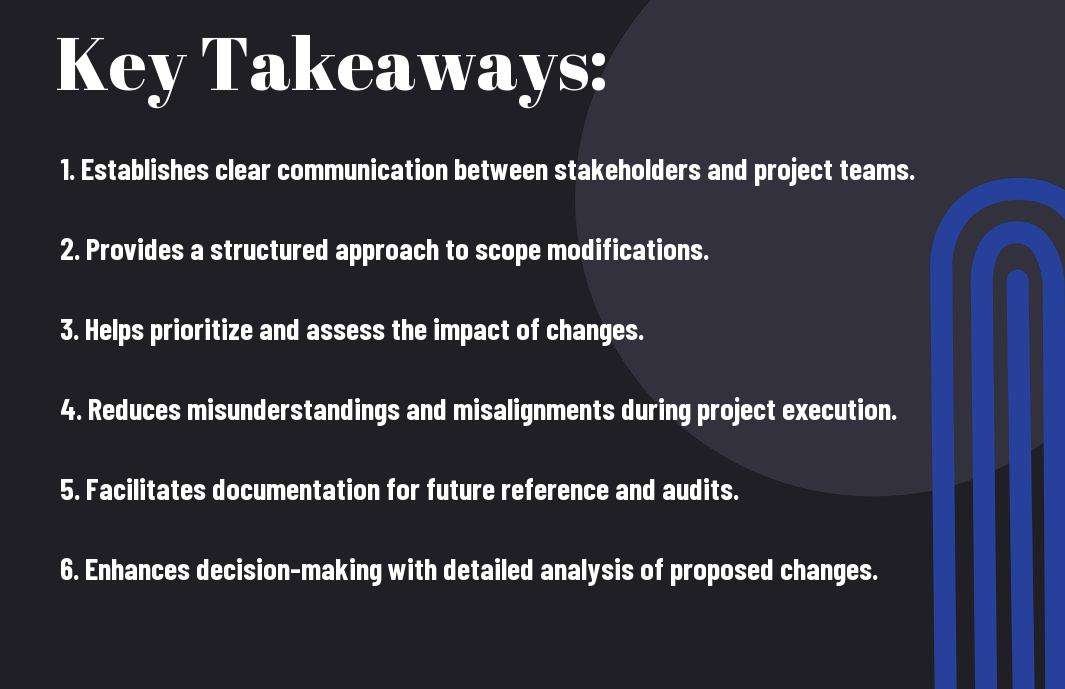Most project managers encounter scope changes at some point, which can lead to confusion and chaos if not handled properly. I believe that implementing a well-structured Change Request Document can significantly streamline modifications in project scope, ensuring that changes are clearly articulated, justified, and approved. This document serves as a formal mechanism for communicating alterations, making it easier for you to manage expectations, maintain project integrity, and ultimately achieve successful outcomes without derailing your timeline or budget.
Key Takeaways:
- Clarity: A change request document provides a clear framework for detailing specific modifications, ensuring that all stakeholders understand the scope changes being proposed.
- Documentation: By formally documenting requests, teams create a record that can be referenced later, aiding in accountability and tracking progress throughout the project.
- Approval Process: The document establishes a structured process for reviewing and approving changes, helping to prevent scope creep and miscommunications within the project team.

Understanding Change Requests
A change request is a formal proposal to modify any aspect of a project, allowing for necessary adaptations as conditions evolve. This imperative document ensures that all stakeholders are on the same page about the alterations and provides a structured method for implementing these changes. If you want to dive deeper into the processes involved, check out my post on How to Handle Scope Changes in Project Management.
Definition and Purpose
Above all, a change request serves as a documented means of communication that outlines the reasons for change, the impact it will have, and the proposed solutions. It acts as a reference point for discussions and decision-making to maintain clarity throughout the project.
Importance in Project Management
Definition: Change requests hold significant weight in project management by systematically addressing any alterations required during a project’s life cycle. These documents facilitate effective communication among stakeholders, ensuring that everyone involved is informed and aligned.
Considering the dynamic nature of most projects, managing scope changes through formal change requests is imperative. It allows you to proactively assess impacts on timelines, resources, and budgets while maintaining project integrity. By utilizing change requests, I can mitigate any risk of scope creep, ensuring that modifications are made with a clear understanding of their implications. This process promotes accountability among team members, allowing you to keep the project on track and aligned with your initial objectives.
Components of a Change Request Document
Some key components of a change request document include a detailed description of the change, impact analysis and justification, a timeline for implementation, and resource requirements. These elements ensure all stakeholders have a clear understanding of the proposed modifications and their implications, contributing to informed decision-making.
Detailed Description of Change
For an effective change request, you need to provide a comprehensive description of the proposed change. This includes outlining specific modifications, their context within the broader project, and any related documentation. Clear articulation helps stakeholders grasp the rationale behind the request and evaluate its merit.
Impact Analysis and Justification
Below, you’ll find that a thorough impact analysis and justification section is vital for your change request. It assesses how the proposed changes will affect various project aspects, including timelines, budgets, and resource allocations, while also providing a rationale for why the change is necessary.
To ensure your change request is taken seriously, you must present a well-researched impact analysis. This involves identifying potential risks and benefits associated with the change, allowing stakeholders to weigh the consequences. Highlighting both positive outcomes like improved efficiency and potential drawbacks such as increased costs can provide a balanced view. Establishing a strong justification not only strengthens your case but also fosters trust and transparency in the decision-making process.
The Change Request Process
All changes in a project’s scope require a systematic approach to ensure that modifications are effectively managed. Implementing a change request process can be pivotal for your project’s success. If you want insights into What is a change control process and how do you use it?, you can explore various methodologies that enhance your project coordination.
Submission and Review
Process begins by submitting the change request document, filled with relevant details about the proposed changes. You will ensure that all stakeholders review the submission to assess implications on the project’s objectives, timelines, and resources.
Approval and Implementation
Across the change request process, obtaining approval is vital before any changes can be implemented. You must communicate effectively with decision-makers to clarify any concerns and outline benefits. Approved changes should be documented and communicated to all project members to align everyone on the revised scope.
In addition, effective communication during the approval stages can significantly mitigate the risk of misunderstandings. It’s necessary for you to document all important aspects, including why the change is necessary and potential impacts on the project timeline and budget. This documentation not only ensures transparency but also fosters trust among stakeholders. Use this opportunity to share positive aspects, such as corrective measures that improve project outcomes, while being aware that changes can introduce challenges in adaptation. Your proactive management of these factors will help secure project success.
Benefits of a Change Request Document
For any project manager, a well-defined Change Request Document brings numerous benefits that can significantly enhance project execution. It provides a structured way to present modifications, streamlining the approval process while ensuring that all stakeholders are informed and onboard. By implementing this document, you can reduce misunderstandings and potential project delays.
Enhanced Communication
Documenting change requests fosters transparency among team members and stakeholders. By clearly articulating the reasons for changes, their impact on the project timeline, and the budget, everyone involved can collaborate more effectively, leading to a more cohesive project environment.
Improved Change Management
Change management in projects can be a daunting task. However, with a structured approach to documenting changes, you can ensure that all modifications are tracked and assessed for their impact on project objectives.
At the core of effective change management is the ability to respond promptly to evolving project needs. By using a change request document, I can safeguard against unplanned alterations that may derail progress. This document serves as a central point for assessing impacts, enabling me to prioritize necessary changes while avoiding scope creep that can negatively affect timelines and budgets. Consequently, you achieve a more organized and controlled project workflow, ultimately leading to project success.

Best Practices for Creating Change Request Documents
Keep your change request documents clear and well-structured to facilitate understanding and approval. Adequate details about what modifications are being proposed can make a significant difference in how quickly and efficiently a project can adapt to new requirements. Sticking to a consistent format can also help streamline the review process and minimize confusion among team members.
Clarity and Precision
By providing clear and precise information in your change request, you minimize misunderstandings and create a solid foundation for decision-making. Ensure that each request includes specific details about the changes needed, their impact on the project, and the rationale behind those adjustments. This level of detail not only supports the approval process but also enhances communication among all stakeholders.
Stakeholder Involvement
Practices that ensure the involvement of all relevant stakeholders in the change request process can lead to more informed decisions and smoother implementations. It’s vital to engage those who will be affected by the modifications and gather their feedback during the drafting phase. Their insights can provide necessary context and help identify potential issues before they arise.
Another effective approach is to actively seek input from stakeholders throughout the entire process. Involving key players like team members, clients, and management not only improves the quality of the change request but also increases the likelihood of receiving swift approvals. When stakeholders feel they are part of the process, they are more likely to support changes, which can lead to a smoother transition and better overall project outcomes.
Common Challenges and Solutions
Now, I often encounter several challenges when implementing a change request document. These hurdles can impede the progress of a project and create frustration for you and your team. Understanding these challenges and their solutions can significantly improve the effectiveness of the change process, ensuring smoother transitions and maintaining project integrity.
Resistance to Change
Any change can be met with resistance, as team members might feel uncertain about new directives or fear that their roles could be impacted. To mitigate this, clear communication about the benefits of the requested changes and involving the team in the decision-making process can foster acceptance and reduce pushback.
Maintaining Project Timeline
Around every project, adhering to the schedule can be challenging, especially when changes are introduced. Change requests may create delays, putting pressure on the overall timeline. It’s important for you to prioritize your adjustments and clearly outline the necessary tasks each change entails.
It’s vital to effectively manage your project timeline during modifications to avoid any disruption. By using a structured approach, you can identify key milestones impacted by the change and develop a realistic plan that accounts for any additional resources needed. Implementing a solid communication strategy ensures that all stakeholders are informed and aligned; this can lead to a more coordinated effort where you can adapt timelines and responsibilities smoothly. Ultimately, embracing flexibility will empower you to maintain progress without sacrificing quality or outcome.
To wrap up
Taking this into account, I believe that a well-crafted change request document simplifies the process of managing modifications in project scope. By providing a clear framework for submitting, evaluating, and approving changes, you can ensure that all stakeholders stay informed and aligned. This not only helps in minimizing misunderstandings but also enhances accountability and efficiency in your projects. Utilizing a change request document effectively allows you to manage scope adjustments in a structured manner, promoting smoother transitions and successful project outcomes.
Q: What is a Change Request Document and why is it important in project management?
A: A Change Request Document is a formal written request to modify any aspect of a project, such as objectives, scope, timelines, or resources. This document is crucial in project management because it serves as the official record of proposed changes, ensuring that all team members and stakeholders are aware of and agree on the modifications. By detailing the justification for the change and its potential impacts, it promotes transparency and aids in the decision-making process.
Q: How does a Change Request Document facilitate communication among project stakeholders?
A: A Change Request Document enhances communication by providing a standardized format for presenting proposed changes. This document ensures that all stakeholders receive the same information regarding what is being changed, why, and how it will affect the project. By centralizing important details, it reduces confusion and miscommunication, allowing for informed discussions and quicker consensus on the proposed modifications.
Q: In what ways can a Change Request Document help in managing project deadlines and budgets?
A: A Change Request Document helps manage project deadlines and budgets by outlining the anticipated impact of the proposed changes on existing timelines and financial resources. It allows project managers to assess whether the request will require additional resources or adjustments to the schedule. By evaluating these factors before approving the change, teams can make more informed decisions, thus minimizing unnecessary delays or budget overruns that could arise from unregulated modifications.







